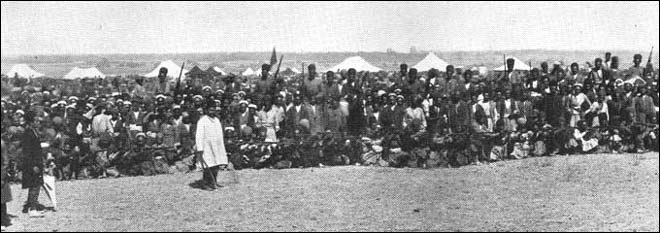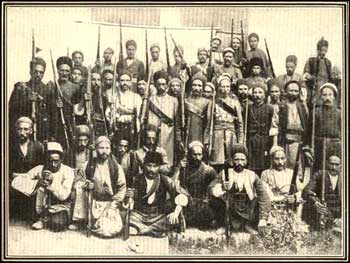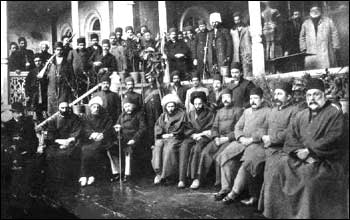Discuss the Revolution of 1905 to 1911 and Its Continuing Relevance for Understanding Iran
Constitutional Revolution During the early 1900s the only way to save country from government corruption and foreign manipulation was to make a written code of laws. This sentiment caused the Constitutional Revolution. There had been a series of ongoing covert and overt activities against Naser o-Din Shah's despotic rule, for which many had lost their lives. The efforts of freedom fighters finally bore fruit during the reign of Moazaferedin Shah. Mozafaredin shah ascended to throne on June 1896. In the wake of the relentless efforts of freedom fighters, Mozafar o-Din Shah of Qajar dynasty was forced to issue the decree for the constitution and the creation of an elected parliament (the Majlis) in August 5, 1906. The royal power limited and a parliamentary system established.
 |
| Bakhtiari Revolutionaries in camp outside Esfahan (June 1909) In front, in a white coat with a sword, is Mohammad Ebrahim Khan, Zabet of Julfa. |
On August 18, 1906, the first Legislative assembly (called as Supreme National Assembly), was formed in the Military Academy to make the preparations for the opening of the first Term of the National Consultative Assembly and drafting the election law thereof. During this meeting, Prime Minister Moshirul Doleh delivered a speech as the head of the cabinet. The session concluded with the address made by Malek Al Motokalemin.
On October 7th, 1906 in a speech made in spite of his poor health, Mozaferedin Shah inaugurated the first session of the National Consultative Assembly. At this time the session was formed in the absence of representatives from provinces.
Following Mozafaredin Shah's death, his successor, Mohammad Ali Mirza who was then ruled Tabriz as a crown prince, ascended to the throne on January 21st, 1907. Before taking the reign, he pledged to respect the fundaments of Constitution and Nation's Rights. But he contravened this from the very beginning which made Constitutionalists to react.
Capitalizing on the internal struggles, both Russia and Britain entered a pact to settle their own differences; effectively dividing Iran into two areas of influence for their respected countries. This made headlines in early September 1907 and united the various factions in Iran. The Iranian government was officially notified of this pact on September 7, 1907 by Russian and British Ambassadors.
The rising tides of dissatisfaction and discontent caused Mohammad Mirza to summon the cabinet members on December 17, 1907 under the false pretense of soliciting advice. He immediately orders their detention. Only Nasserul Molk, who was the prime minister, was let free.
On December 22, 1907 a new cabinet was formed headed by Nezamul Saltaneh Mafi. On the surface the air is cleared and the tensions are eased. But on February 1908, a bomb is thrown at Shah's Coach, making him highly suspicious. On June 1st, 1908 Shah purges some of the courtiers. Ambassador Zapolski of Russia and Ambassador Marling of Britain warn the Iranian Government to submit to Shah's intents.
 |
| Freedom Fighters of Tabriz The two men in the center are Sattar Khan & Bagher Khan. |
During these times, the Tabriz uprising culminated and within the span of four months spread to Rasht, Qazvin, Esfahan, Lar, Shiraz, Hamadan, Mashhad, Astar-Abad, Bandar Abbas and Bushehr. The Freedom fighters prevailed against the tyranny at all points. Yet Tabriz was still under economic and military blocked set up by government forces.
On February 17, 1909, Freedom Forces captured Rasht. By March, they succeed in taking control of Rasht and Qazvin main roads. By April 22nd, 1909, Tabriz Freedom Fighters under the leadership of Sattar Khan (Sardar-e Meli) made their attack to break through the blockade. They lost huge number of their fighters. An English Reporter named Moore and an American Missionary called Howard Baskerville, who were sympathetic with the freedom fighters were killed.
Commanded by General Yeprim and Brigadier Mohi, freedom fighters of Rasht occupied Qazvin and advanced towards Tehran.
On June 22, 1909, Bakhtiari Chieftains, led by Samsam-ul-Saltaneh and Haj Aligholi Khan Bakhtiari (Sardar As'ad) reached the city of Qum, which they took over on July 8th,1909. The intimidations and interventions made by Russian and British embassies failed to stop the advance of freedom fighters. Inevitably, a number of Russian troops were dispatched to Gilan via Badkobeh, reaching Qazvin on July 12th, 1909. Russians warned Gilan Fighters to stop moving in against Tehran.
 |
| A nationalist council at Rasht |
On July 16, 1909, the capital was under complete control of freedom fighters. At 8:30, on the morning of July 17, 1909, Mohammad shah and a number of his supporters, under armed escort of Russian soldiers, took asylum with Russian Embassy in Zargandeh.
On this very day, the National Consultative Assembly (Majlis) held an emergency session and deposed Mohammad Ali Shah as a monarch, and named his 13 year old son, Ahmad Mirza as his successor. Azadulmolk was named as the Vice-Regent.
On September 10th, 1909, Mohammad Ali Shah left the Russian Embassy and went into exile in Russia.
First Term (October 7th, 1906 – June 23rd, 1908)
The most important task undertaken by the first Majlis was drafting and ratification of the Constitution on December 30th, 1906. It also set out the internal procedures. On October 17th, 1907 it drafted and ratified the constitutional amendments.
The first Majlis was dissolved before the end of its Term due to Mohammad Ali Shah's opposition against the Constitutionalists as well as foreign intrigues. Colonel Liakhov, the Russian commander of the Iranian Cossack brigade, along with several Russian officers set artillery fire against Majlis. A number of Majlis Representatives and Constitutionalists were detained in Bagh Shah, of which a number were killed. Some fled to and sought asylum with foreign embassies. Thus the First Majlis was dissolved and a martial law was declared.
Second Term (November 15th, 1909 – December 24th, 1911)
The second Majlis came into session after a period of Interregnum that lasted almost 17 months. A two-stage, indirect plebiscite was carried out. Confronted with severe crises and dilemmas arising from interventions by foreign forces and domestic hardships, Majlis stood its ground as far as possible. Finally it was dissolved under foreign pressure. The representatives either fled or went into exile.
Nevertheless important bills were passed during this time. These included the Public Tax Act, Bureau of Audit Act, the new election law, and the Education Bill.
Third Term (December 6th, 1914 – December 14th, 1915)
The Third Majlis did not last more than a year. Faced with the First Word War, Majlis representatives declared Iran's neutrality. Nevertheless, Iran's neutrality was blatantly transgressed by foreign expeditionary forces. The Czarist Russian Army expeditionary force left Qazvin for Tehran, bringing up the question of relocating the capital. It raised concerns and led to riots. A number of representatives moved to Qum and from there to Kermanshah. Majlis session could not be held due to lack of quorum. It finally adjourned in November 12th, 1915.
During this period, Majlis approved important laws such as the Military Conscription Act, Ministry of Finance constitution bill, and Real Estate tax law.
Fourth Term (June 21st, 1921 – June 20th, 1923)
Following a long interregnum , that lasted five years and seven months), the Fourth Majlis was inaugurated. Most of its time had been spent in tension and rancor.
The most valuable action taken was when it drafted and approved a bill submitted by Majlis majority leader Seyyed Hassan Modaress. The bill called for the abolition of the 1919 accord, signed between the Iranian Prime Minister and the British Government without Majlis knowledge. The accord had been put into effect before Majlis had any chance on debating it.
Moddares' bill, once approved, was announced publicly and the British government was formally notified.
The most important legislations passed during this period had been:
Fifth Term (February 11th, 1924 – February 11th, 1924)
One of the tumultuous periods in Majlis, when a combination of generalissimo and foreign influence joined forces to put an end to the Qajar Dynasty. Independent Majlis representatives were harassed, intimidated and even assassinated in order to have the Minister of War, Reza Khan, installed to the throne.
Some of the important bills and legislations approved by Majlis during this period were:
Sixth Term (July 10th, 1926 – August 13th, 1928)
The most important event during this period had been the abolition of Capitulation on May 9th, 1927.
Some of the important bills and legislations approved by Majlis during this period were:
Seventh Term (October 6th, 1928 – November 5th, 1930)
Majlis granted the right of issuing currency to the Iran National Bank (Bank Melli Iran). This task used to be carried out by Iran Royal Bank.
Among the important bills and legislations approved by Majlis during this period were:
Eight Term (December 15th, 1930 – January 14th, 1933)
During this period the Minister of Treasury proposed that Darcy License , which monopolized the Iranian oil fields, be cancelled.
The most important bills passed by Majlis at this time were:
Ninth Term (March 15th, 1933 – April 10th, 1935)
The period saw negotiations with the British government over petroleum. It led to a new agreement. The Tehran University was inaugurated on February 4th, 1936.
Some of the most important legislations were:
Tenth Term (June 6th, 1935– June 12th, 1937)
The most important event during this period had been negotiations for the signing of non-aggression pact between Iran, Afghanistan, Turkey and Iraq.
The most important legislations ratified were:
Eleventh Term (September 11th, 1937 – September 18th, 1939)
The Second World War conflagrated at this time. Iran proclaimed its neutrality in the conflict.
Among the important bills and legislations approved by Majlis during this period were:
Twelfth Term (October 25th, 1940– October 30th, 1941)
Numerous social and economic problems arising from the Second World War gripped the country. While Iran had declared its neutrality, Soviet Union and Britain blatantly disregarded it and sent in their troops into Iran under the pretext of supposed Reich influence in Iran.
During an emergency session on September 17, 1941, Reza Shah abdicated in favor of his son, Mohammad Reza who was sworn in as the new monarch on the next day. Meanwhile with the Generalissimo Reza Khan out of the way, Majlis passed a bill of pardon and clemency for a number of political and general sentences.
Thirteenth Term (November 13th, 1941 – November 23rd, 1943)
This period coincided with the Tehran Conference attended by the head of states of Britain, Soviet Union and United States, where the territorial integrity and political independence of Iran was guaranteed.
Important bills and legislations approved during this period were:
Fourteenth Term (February 26th, 1944 – March 11th, 1946)
The plebiscite was taken while Allied troops still occupied parts of Iran. The political parties and groups that were formed following Reza Khan's fall from power, made active bid for Majlis seats. This led to some unrest in some of the electoral districts. With the cessation of Second World War, there had been foreign instigated insurrections in Azerbaijan and Kurdistan.
Some of the noteworthy bills passed by this session of Majlis were:
Fifteenth Term (July 17, 1947 – July 28, 1949)
Important bills and legislations approved by Majlis during this period were:
Sixteenth Term (February 9th, 1950 – February 18th, 1952)
A tumultuous period, deeming Gass-Golshaiyan contract amendments against government interest, Majlis expressed its opposition. The Select Petroleum Committee submitted its proposed amendments for Nationalization of Iranian Oil Industry. The British Government lodged a complaint with the International Tribunal in Hague. The Tribunal issued a restraining order preventing the Iranian government from measures it had already taken for transfer of oil industry to Iranians. Quoting inattributibility of the Tribunal in the case, the Iranian government deemed the order as being invalid. The British closed their consular offices in Iran.
Some of the noteworthy bills passed by this session of Majlis were:
Seventeenth Term (April 25h, 1952 – December 19th, 1953)
This session, like the one before it, was plagued with political turmoil and unrest. Election was carried out with some difficulties, with some seats remaining vacant through out Majlis abnormally short life. Only 80 representatives were present out of 135. The issue of oil predominated most of the discussions.
The British government did recourse to International Tribunal in Hague, this time the Iranian Prime Minister attended the hearings. In a vote, the International Tribunal ruled that it is incompetent to deal with British claim regarding nationalization of oil industries. It is noteworthy that the British arbitrator did caste its vote in favor of the motion, which was passed 9 to 5. This led to complete break of political ties with the British government. The Majlis terminated the Iran-Soviet 1927 Caspian Sea Fisheries agreement and nationalized its facilities.
Shah was put to exile, only to be restored to power in a CIA-sponsored coup d'etat. Upon return, he promptly dissolved both Majlis and the House of Senate.
Of the bills passed during this period one could mention the following:

 Pictures of Constitutional Revolution, 1906 - 1911
Pictures of Constitutional Revolution, 1906 - 1911 Source: https://www.iranchamber.com/history/constitutional_revolution/constitutional_revolution.php
0 Response to "Discuss the Revolution of 1905 to 1911 and Its Continuing Relevance for Understanding Iran"
Post a Comment